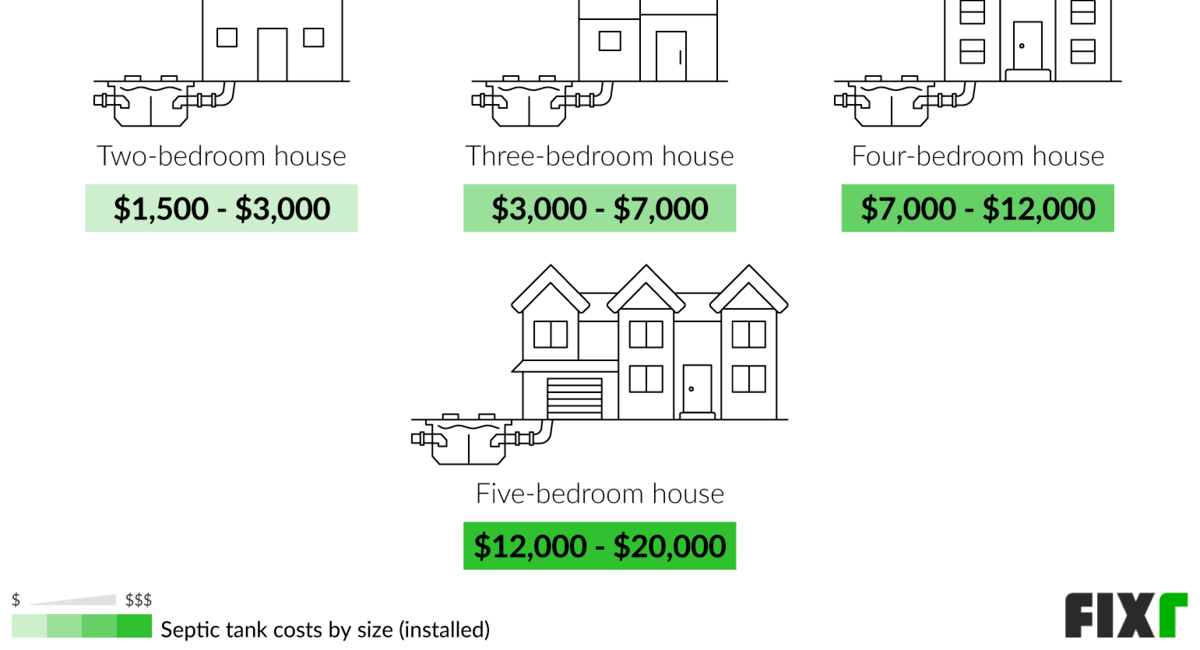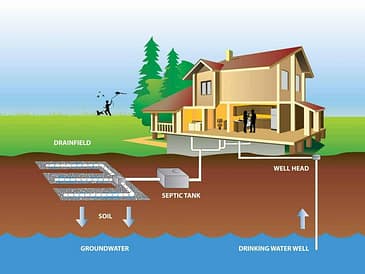Septic systems provide homes without access to public sewer services with an effective waste disposal solution, but when they malfunction they can create unpleasant odors within your home and be an annoyance.
Installing a septic tank may cost more than you expected; especially if the soil cannot support one. Any issues will add additional expenses.
Concrete
An excellently constructed and maintained concrete septic tank should last many years with proper care and maintenance. But if it becomes overloaded or leaks occur, waste may seep into the soil causing foul odors; then it is likely necessary to replace this particular septic system.
According to Bob Vila, the cost of installing a new concrete septic tank varies depending on its size and construction material – for instance a 1000 gallon fiberglass unit will typically be cheaper than an equivalent-sized concrete one. Other factors affecting its cost include installation location, soil composition and permitting requirements.
Though installing a septic tank yourself is possible, most professionals would advise leaving this task to professionals. Labor costs play an integral part of any installation cost and a professional can ensure your tank meets all required sizing specifications while installing all required components – not forgetting land survey costs!
Septic tank sizes and pumping schedules depend upon how much waste enters them; failure to do so regularly could result in overflows that require costly and unpleasant cleanup efforts. Septic tanks should be inspected and pumped out every three years for best results.
Home septic systems often include more components than just the main septic tank. A drain field and leach line are both necessary components, with installation costs typically ranging between $3,000-$4,000 for drain fields and leach lines to run from your house directly to the tank and backfill the area around it.
Budget for additional add-ons and expenses related to your project such as:
Plastic
Before choosing which septic tank and leach field to install, many factors need to be considered when making this important decision. These include factors like your home size, amount of waste flow and material used in its construction. Furthermore, state regulations should also be taken into account as they dictate minimum sizes required as well as whether permits and inspection are needed before installation commences. Finally, pricing information should also be understood prior to beginning this process.
Professional septic tank installers can assist in estimating the costs associated with replacing your septic tank based on factors like house size, number of bathrooms and location. In addition, they will conduct percolation tests and system designs in order to assess what size tank would best meet your soil composition and drainage needs.
Once you have an idea of price, it is advisable to obtain multiple estimates from various companies in order to find the most cost-effective one and ensure quality materials and proper installation procedures are being used by your contractor. Furthermore, preinstallation tasks that can be completed yourself could save money too!
Your choice of septic tank will have a direct impact on the longevity of your home. While concrete tanks tend to outlive other options, they may eventually crack over time and require special construction and lifting equipment for installation. A cheaper and less maintenance-intensive alternative would be fiberglass or polyethylene septic tanks which may break more easily due to shifts in water tables and soil conditions.
Your family size and changes in water usage can also impact the lifespan of your septic system, with oversizing not being enough to handle wastewater produced at home, while undersized systems could cause sewage backup into your home or leak onto nearby land, potentially polluting nearby sources with nitrates and nitrites – essential factors when considering maintaining and inspecting a septic system regularly inspected and pumped-out for best performance.
Fiberglass
Septic tanks serve an integral function in rural homes that do not connect to public sewer systems, providing drainage and wastewater treatment functions. Although costly to install and maintain, septic tanks are an essential necessity in such regions. Septic tank replacement costs can vary significantly based on factors like tank type and other considerations – according to HomeGuide estimates, for a 1,250 gallon concrete septic tank this costs roughly $2,510 while for fiberglass ones it comes to roughly $2350; additional factors which affect costs could include installation, excavation and labor charges as well.
Plastic septic tanks can last a long time with proper care, but they may crack, rust and be damaged during installation. A fiberglass tank, however, offers increased corrosion resistance and less chance of cracking during assembly compared to plastic counterparts; plus their lightweight structure makes transport and installation much simpler on site.
Concrete septic tanks are the go-to choice, yet can be expensive and difficult to repair. Cracked or leaky concrete tanks may lead to groundwater seepage. For an economical option that won’t break the bank, plastic or fiberglass septic tanks could be better options.
Septic tank installation is a complex project that should only be undertaken by professionals. The job will include excavating and installing the septic tank, perforated pipes, and drain field. Furthermore, fencing will need to be put up around the area as well as tree roots removed before you can obtain a permit for its installation.
Installation of a septic tank typically takes two or three days. After the tank and pipe have been connected, an inspection test will be performed to make sure everything works as intended before covering of both structures by installer.
Septic systems can last as long as 40 years when properly maintained, but regular inspections are essential to keeping it functioning smoothly and preventing problems with its tank. At least twice annually should be spent pumping it. Regular inspections also help identify any potential issues which could occur with its functioning.
Steel
Price for a new septic tank will depend on construction material, size, installation costs and other considerations. A concrete tank of certain dimensions typically costs $700-$2,000 before installation; while fiberglass versions can often be significantly less.
Homeowners can determine the cost of installing a septic system by gathering quotes from several companies and discussing their individual needs with professional installers. A professional will help determine which type of system would work best with their home and budget while explaining any advantages or disadvantages of each type. In addition, they may suggest the size of tank needed.
When it’s time to upgrade a septic tank, homeowners should carefully consider its impact on home value. While an operational tank adds value, any leaks or failure can reduce its worth significantly; replacing an outdated or inoperable septic tank may provide peace of mind while giving homeowners access to comfortable living conditions.
An effective septic system requires regular pump-out. Food scraps, paper towels and other waste must be removed from the septic tank before it overflows into the drainfield or accumulates to clog the drainfield or even overflow into your home. Without pump-out services available regularly to maintain this function of your system, solids could accumulate until clogging it or overflowing onto your property is inevitable.
Homeowners will also need to cover the installation and piping costs associated with their tank purchase. Installation typically entails digging holes for the tanks and pipelines before installing both and performing any required plumbing and electrical work. In certain instances, purchasing permits and paying inspection fees will also be necessary.
A concrete tank will last the longest but also cost more than plastic or fiberglass models; depending on its size, a homeowner should expect to spend between $3,500 and $10,000 for an entire system.





